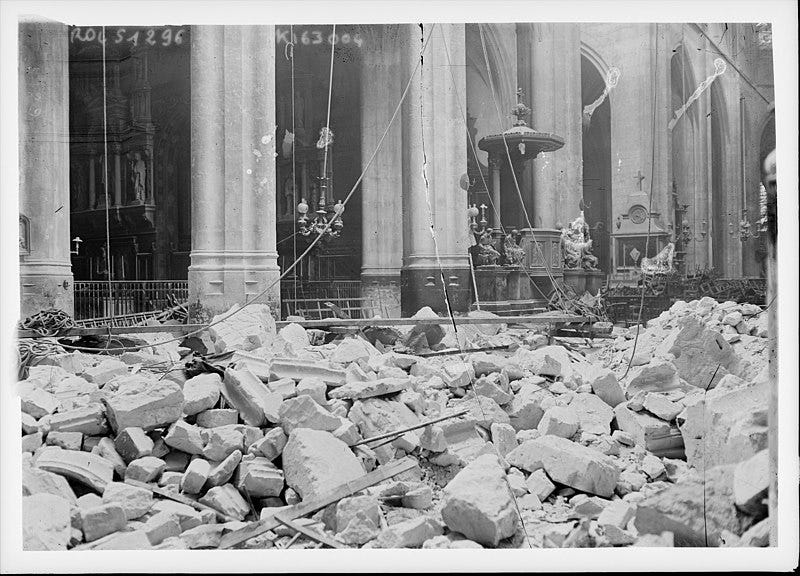The Forgotten Artillery: World War I's Stratospheric Shells
Written on
Chapter 1: The Dawn of Stratospheric Warfare
In today’s world, space exploration captivates our imagination, driven by pioneers like Elon Musk and SpaceX, who have us envisioning interplanetary travel. However, the journey into the upper atmosphere isn't as modern as it seems. Surprisingly, the first human-made object to breach the stratosphere was launched during World War I, not the Cold War era. This remarkable feat was achieved with an artillery shell rather than a rocket, demonstrating the ingenuity of the time. In 1918, Germany developed a weapon capable of firing a shell to extraordinary heights, a true testament to human innovation.
On March 21, 1918, Paris experienced a shocking event: a series of explosions that left residents bewildered. The source of the blasts was a mystery, as no aircraft or artillery was visible nearby. German forces were positioned over seventy miles from the city, raising questions about the origins of these attacks. An impactful strike occurred shortly after, when a shell landed on the Church of Saint-Gervais-et-Saint-Protais during a crowded Good Friday service, resulting in around 100 casualties from debris.

This unexpected bombardment shocked Parisians, as the largest artillery pieces of the time typically had a range of about twenty miles. The realization that they were now vulnerable to attacks from a distance sparked panic, with many families evacuating the city.
Section 1.1: Historical Context of Large Artillery
The concept of powerful artillery is not new. As early as 1453, the Ottomans showcased the devastating potential of large cannons by breaching the formidable walls of Constantinople. One such cannon, enormous and crafted from brass, required sixty oxen for transport when disassembled. This historical precedent set the stage for future innovations in artillery technology.
Isaac Newton, in his 1687 work Principia Mathematica, theorized about the possibility of a cannon capable of launching projectiles into space. Furthermore, the renowned science fiction writer Jules Verne envisioned a future where a giant cannon could send passengers to the moon in his 1865 novel From the Earth to the Moon. Such ideas were not merely fanciful; they reflected humanity’s long-held dreams of reaching beyond our planet.
Subsection 1.1.1: The Paris Gun
The formidable artillery piece used during World War I was known as the Paris Gun. Contrary to initial claims, the Germans had not just one but three of these massive cannons. Each was constructed from three naval gun barrels welded together, weighing an astonishing 154 tons. The entire assembly, including its cradle and railway wagon, weighed over 400 tons.

These guns were capable of launching a 265-pound shell into the stratosphere, reaching Paris—approximately seventy-five miles away—in about 170 seconds. This unprecedented achievement marked the shell as the first man-made object to reach such heights, as noted in reports from the period. Major Arthur F. Cassels, writing in the Field Artillery Journal, highlighted the ballistic efficiency gained at these altitudes, though he also warned of the complications introduced by the Earth’s rotation, which affected trajectory.
Section 1.2: Challenges of Stratospheric Artillery
As the shells ascended, the decreasing air resistance enhanced their ballistic performance. However, this advantage came with significant challenges. The sheer force required to fire these shells—400 pounds of gunpowder—caused considerable wear on the barrels, necessitating frequent re-boring.

Despite the engineering marvel that the Paris Gun represented, its effectiveness was limited. From March to August 1918, the three guns fired only 367 shells, resulting in 256 fatalities. The infamous church strike accounted for a significant portion of these casualties. The challenge of accurately targeting an area from such a distance proved nearly impossible, as the shells spread across the city.
Chapter 2: The Legacy of the Paris Gun
The video titled "The First Man-Made Object in Space" delves into the history and implications of this extraordinary artillery shell, shedding light on its significance in both military history and the evolution of aerospace technology.
Though the Paris Gun was dismantled before the war concluded, its legacy endures. Modern technology has evolved beyond such artillery, but the concept of launching objects into space through powerful cannons is not entirely obsolete. Companies like Quick Launch are exploring the feasibility of “space guns” to deliver payloads into orbit at a fraction of the cost of traditional rockets.
The United States Army is also developing a Strategic Long Range Cannon (SLRC), with ambitions of achieving a range of 1,000 miles. While rockets dominate the current landscape of space exploration, the innovative spirit of the past continues to inspire advancements that may one day bridge the gap between old and new methods of reaching the stars.